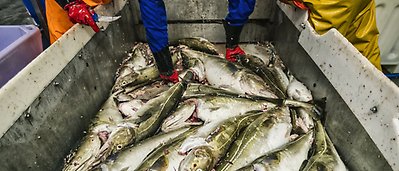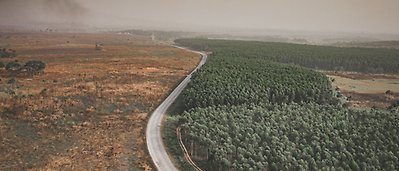
Despite increased focus on the sustainability of the seafood sector, freshwater use in seafood production has received relatively little attention. A new study published in the journal Advances in Water Resources warns that this water-related ‘seafood gap’ is increasingly important given growing global seafood demand and prospects for growth of the industry. Photo: J. Lokrantz/Azote
Bildtext får vara max två rader text. Hela texten ska högerjusteras om den bara ska innehålla fotobyline! Photo: B. Christensen/Azote
Seafood production
How much water in a fish?
New study introduces the 'seafood gap', the forgotten freshwater use in seafood production chains
• The freshwater use of seafood is generally forgotten in food-water nexus analyses
• This water-related ‘seafood gap’ is increasingly important given growing global seafood demand and prospects for growth of the industry
• Study provides three cases to highlight different water use concerns in aquaculture and suggest new ways to integrate seafood into the broader food-water nexus
No freshwater, no food, not even seafood. People around the world eat more and more fish and shellfish. Since the early 1960s global seafood consumption has grown at an annual rate of almost four percent, or twice as fast as human population growth.
Recently, there has been an increased focus on the sustainability of the seafood sector, with greater consumer interest and more responsible seafood corporations. Despite this, freshwater use in seafood production has received relatively little attention, with most water use analyses focusing on agriculture, industry and domestic water use.
As seafood consumption continues to increase globally, this ‘seafood gap’ in the food-water nexus literature need to be considered
Max Troell, co-author
The article, published in the journal Advances in Water Resources, has Jessica Gephart from the University of Maryland as first author along with centre researchers Patrik Henriksson and Lisa Deutsch as co-authors. Reviewing different water use concepts and how they relate to seafood production the authors come to the conclusion that better water use accounting for seafood seems feasible in the coming years.
Cases from China, Egypt, and Indonesia
The study looks into the freshwater use of capture fisheries and aquaculture, while also including considerations of water quality impacts from release of for example organic matter, nutrients, disinfectants and antimicrobials. Besides the global outlook the study also features three cases from China, Indonesia and Egypt.
Calculations of the freshwater consumption of China’s aquaculture indicate a footprint ranging between 2,000–57,000 litres per kilo. In comparison it has been calculated that a kilo of beef requires about 15,000 litres to be produced whereas a kilo of chicken meat has a water footprint of around 4,000 litres. Most of the Chinese seafood water footprints are composed of feed-associated water use. In other words this is how much water that is needed to produce the crops included in the feed.
Different kinds of water requirements
“Capture fisheries and aquaculture contribute equally to global seafood production, but capture fisheries require essentially no freshwater inputs” says leading author Jessica Gephart. Apart from the relatively small water use associated with capture (e.g. water use in oil refineries), transportation (e.g. ice, and ship maintenance) and processing there is now freshwater use.
A sufficient amount of freshwater for living conditions must, however, remain in fresh- and brackish water ecosystems to sustain the habitats that the fishery depends upon. This implies that reduced freshwater flows or lake levels can result in the loss of habitats for fish refuge and spawning.
The authors conclude that it is high time to start addressing the ‘seafood gap’ to enable better analyses of potential synergies and trade-offs between seafood and terrestrial foods. This could improve future food-water scenarios and lead to more well-informed decision-making and policy considerations.
"Specifically, analyses of trade-offs in diets and of diet scenarios and proposed environmental labelling and certification schemes require meaningful methodology across the full range of products," Patrik Henriksson concludes.
Without this kind of bridging of the seafood gap, the potential water impacts on (and from) the growing aquaculture sector may remain unaccounted for. Another fear is that insufficient water may be reserved for environmental flows that support capture fisheries.
Methodology
The study applies several different methods for quantifying water use. For example, the authors calculate the water footprint of aquaculture in China using a method “aligned with the simplified blue, green, and grey water footprint concept developed by the Water Footprint Network”. In doing so, they illustrate the water use hotspots and briefly discuss regional scarcity. They then present results from a Life Cycle Assessment-based study on water usage in Indonesian aquaculture and use this to illustrate the large difference among species and farming systems. They also present an aquaculture case from Egypt to illustrate issues related to water quality and the prioritization of water usage.
Gephart, J. A., Troell, M., Henriksson, P.J.G., Beveridge, M.C.M, Verdegem, M., Metian, M., Mateos, L.D. Deutsch. L. 2017. The’seafood gap’ in the food-water nexus literature—issues surrounding freshwater use in seafood production chains, Advances in Water Resources (2017), doi: 10.1016/j.advwatres.2017.03.025
Max Troell is a system ecologist mainly working with environmental problems associated with aquaculture. This work focuses on inter-linkages between aquaculture and fisheries, on different spatial scales.
Patrik Henriksson is a postdoctoral researcher at the Beijer Intistitute of Ecological Economics and Stockholm Resilience Centre. His main research interests are related to identifying and promoting more sustainable aquaculture practices.
Lisa Deutsch is a Senior Lecturer on the couplings between the ecological effects of globalization of food production systems and national policy and economic accounts.









